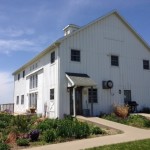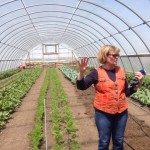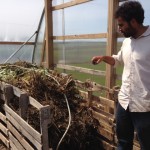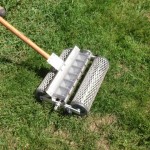Today’s characters ranged from the tip top of the “food chain” to the near bottom. We began the day by running to the Capitol building in Des Moines to meet Lt. Governor Kim Reynolds. Unfortunately, the meeting was very short, meaning 15 minutes or so. As Rachel said earlier, she basically told us about Iowa’s agricultural heritage and importance in the world. She also briefly outlined Iowa farmers’ almost near unanimous opposition to the proposed loosening of the Renewable Fuel Standards (meaning not as much ethanol would be mixed with gasoline). Considering that her main platform during her tenure is economic development, she approached this issue from an economic standpoint rather than an environmental one, which, I admit, does have more wide spread appeal. To summarize the issue: lower RFS standards = lower demand for ethanol = lower production of ethanol = lower demand for corn = loss of ethanol related jobs and lower income for corn = bad policy decision for Iowa.
I guess I should get used to these 15 minute visits (or less) if I want to get into politics for a career, but this meeting would have been exponentially more meaningful if it was extended to only 30 minutes. That way, she could have said her spiel about Iowa (that I think I’ve read on the back of every map in our van), and we could have asked our own questions. Nonetheless, the meeting was mostly redeemed by the beautiful capitol building. It was very open and spacious, laid out in the same pattern as the national Capitol and most bicameral legislative buildings, and had a very earthy color scheme throughout the interior. After the meeting, we poked our heads into the House and the Senate chambers–which looked very much alike, except the latter having fewer desks–and the State Capitol Law Library.
- Outside of the capitol.
- The ceiling of the rotunda.
- (I think this is the House chamber…or the Senate…)
- The Capitol Law Library.
- The group!
We then drove a good ways to get to the second of the Wallace Centers: the Country Life Center. This location featured the farmhouse in which Henry A. Wallace was born and a small 11-acre farm that provides the produce for the restaurants here and at the Wallace House in Des Moines (which we visited last week). After being treated to another excellent meal, we were set to work with Mosa Shayan, the farm manager. He graduated from Simpson College (Indianola, IA) with a degree in economics and philosophy, but his passion for composting (lauded by the Wallace Center CEO, Diane Weiland) led him to the Country Life Center. He gave us a short run-down of the farm’s operation and then tasked us with thinning out the green beans he planted earlier in the season because he had planted them too close together earlier in the season. It was pleasant work, despite my Scottish skin’s penchant to freak out before graciously welcoming the sun’s gift of vitamin D.
- The Wallace Country Center farm.
- Showing us the hoop barn (a greenhouse).
- Workin’ hard.
- Mosa showing HN how to get his hands dirty.
- Mosa showing us his prize compost pile.
- A personal planter.












